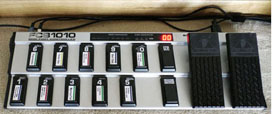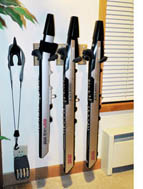Important note (June 2019): Akai has (unfortunately) discontinued the EWI 4000s. The Akai EWI 5000 is now the only similar instrument in their product line.
 EWI is an acronym for either "Electronic Wind Instrument" or "Electric Wind Instrument" - specifically, the Akai EWI 4000s for the purposes of this page. Let me get one thing out of the way at the beginning: This instrument is not, in any sense, a toy. This is a common misconception held by people accustomed to seeing, or playing, standard acoustic musical instruments. To the contrary, in the right hands the EWI becomes a truly expressive and capable wind instrument. This came as a bit of a revelation to me when I first began playing it. My initial positive impression has only been reinforced as I have gained skill. This page will explore this peculiarly versatile and unusual instrument.
EWI is an acronym for either "Electronic Wind Instrument" or "Electric Wind Instrument" - specifically, the Akai EWI 4000s for the purposes of this page. Let me get one thing out of the way at the beginning: This instrument is not, in any sense, a toy. This is a common misconception held by people accustomed to seeing, or playing, standard acoustic musical instruments. To the contrary, in the right hands the EWI becomes a truly expressive and capable wind instrument. This came as a bit of a revelation to me when I first began playing it. My initial positive impression has only been reinforced as I have gained skill. This page will explore this peculiarly versatile and unusual instrument.
All musical instruments, excluding sounds like the human voice and clapping hands, are machines. Pianos, violins, trombones, hi-hats, guitars, timpani, sitars, upright basses, and on and on: They are all devices invented as a means of producing sound, usually pitched, in a controllable fashion. They can be classified into Percussive (drums, chimes, piano, etc.) or Sustain (most wind and string instruments) categories with most being able to do a form of both. Only the method of sound generation and amplification varies between instrument types, standard instruments being primarily mechanical and directly acoustic. The now nearly ubiquitous practice of full public address system amplification has greatly reduced the directly acoustic aspect during most public performances of live music where very little of the actual direct radiation of sound waves from the instruments reaches the audience. The primary remaining exceptions to this are in classical music and some acoustic jazz. Anyway, the EWI is just another machine for controllable sound production. The difference is that it uses an electronic, as opposed to a mechanical, means of sound generation and amplification. It is equally valid as a tool for musical expression - just different and far less familiar. In a recording situation it even has advantages over its mechanical brethren because it is a musical chameleon of sorts and can take on many roles rather effectively, as I hope to demonstrate below. If I don't succeed, complain to my congress person - or my grocer.
![]()
EWI Overview
Electronic Wind Instruments have been around for over 30 years now, thanks to pioneers like Nyle Steiner, but my personal experience with them began in 2008. The outward appearance of the Akai EWI 4000s vaguely resembles that of a clarinet or oboe. Unlike an acoustic instrument, the EWI produces no sound of it's own - instead, it produces electronic data which is used to control electronic sound sources. The data is generated by the sensors in its mouthpiece, contact keys, octave rollers, glide band, and pitchbend sensors. It is fully capable of responding to changes in breath to affect the loudness/brightness of the sound and gives the player control over vibrato through a bite sensor in the mouthpiece, although other diaphragmatic techniques can also be used for tremolo/vibrato effects. Standard tongue/slur articulation techniques work well. While its layout of keys is similar to a woodwind instrument it can be configured to respond to a variety of different fingering options - general EWI, sax, oboe, flute, and brass. As a former trumpet and valve trombone player I have chosen to use the brass-like fingering configuration. I mistakenly thought this EVI (electronic valve instrument) mode would make the learning curve less steep since it partly mimics the three finger patterns of valve instruments that I already knew so intimately. Unfortunately, it probably didn't actually ease the learning curve very much because additional fingers are used both front and back of the instrument and fingering does not change through the octaves as it does with a brass instrument; new fingers/patterns = new habits (See Brass fingering Mode video below.) No matter. As with any instrument, the EWI requires a not-inconsiderable investment of time to acquire the necessary skills to make the operation of the instrument second nature.
There are a number of differences between the EWI 4000s and its younger and smaller sibling the EWI USB. The 4000s is the advanced, professional instrument and, correspondingly, about twice the price. In comparison, the EWI USB is intended as a student instrument, although it certainly can be used professionally and often is. There are many extra features in the EWI 4000s compared to the USB but one of the most obvious is the built-in synthesizer. The USB, on the other hand, connects directly to the user's computer through the USB port and triggers software sounds installed on the computer. It should be said that the EWI 4000s can also trigger sounds installed on a computer or directly trigger a variety of hardware sound modules using its MIDI data output port. Both EWI's require headphones or some type of amplifier and speaker to hear the sound output.
One interestingly relevant point for a portion of the musician population (which includes me): The EWI is an intriguing choice for the aging wind musician. Most instruments make physical demands upon a musician's body - demands that can lead to injury and pain. Compounding this issue is the natural aging process which simultaneously decreases physical capabilities and introduces such wonderful inflammatory calamities like arthritis. Simply put: If you can blow a little air and move your fingers, you can play this instrument. Play it a little or play it a lot. I have arthritis in my fingers and have found that I can play this instrument for hours without incurring any pain or injury. The constant non-stressful motion of the fingers on the stationary contact switches actually appears to be therapeutic; the more time I spend on the instrument, the better my fingers feel. No tired embouchure either, no matter how long I play. Ultimately, there is no price to be paid the following day for "overdoing it." Very cool indeed. Fewer obstacles between me and the music.
Not that everything on the EWI is smooth sailing. All instruments have their challenging technical areas and, with the EWI, one is fingering accuracy. Most instruments forgive small errors in finger timing and synchronization. The EWI, on the other hand, leaves zero room for errors in finger synchronization; either your fingers strike the electronic sensors with exactly the right timing or you will get a "glitch" in the sound - there is no "fudge factor." This means that considerable practice is required (read: repetition) to achieve sufficiently reliable finger habits. If patience is not one of your virtues then this instrument is almost certainly not for you - at least not if you wish to play at a near-professional level or better.
In the interest of full disclosure, let me state that I was not a totally disinterested party to the development of the EWI USB. Akai licensed sounds and the ARIA sample player for the EWI USB from the Garritan Corporation. Personally, I actually had very little to do with its development which was done almost entirely by Akai and Plogue. However, this partnership is the reason for my introduction to the EWI and its possibilities.
In the sections below I have created a number of brief musical examples, most of them improvised, to help illustrate the capabilities of the EWI in different contexts and with different sound sources. First up is the internal EWI 4000s synthesizer:
![]()
The EWI4000s Using Its internal Synthesizer
One of the advantages of the EWI4000s is its self-contained nature. It is possible to plug the audio out of the instrument into an amp/speaker and have everything you need for performance. I have replaced the internal factory sounds with the superior ones offered by Patchmanmusic.com. I took these and made a few tweaks of my own using the included editing software. The software is installed on my computer and a MIDI interface is used for bi-directional communication with the EWI. The sounds are not generally intended to emulate specific acoustic instruments of any kind but resemblances do surface now and then with some of the programming.
![]()
 The following is a contextual example of a synth sound that has some interesting flugelhorn-like characteristics. The tune is an original of mine called "AmyElle." Rhythm section instruments are generated using the extraordinary RealTracks feature of Band In A Box by PG Music. On all of the following tracks where I have used specific chord changes I have included a chord chart on the right. As these are excerpts the recordings don't always begin from the top of the changes the way this first example does; I'll leave it to you to spot the locations - good ear training. Clicking on the chord charts will enlarge them if you wish to examine them more closely. Note that all chord changes read in the key of "Bb" because, as a brass player, this is how I was thinking of them as I played the examples.
The following is a contextual example of a synth sound that has some interesting flugelhorn-like characteristics. The tune is an original of mine called "AmyElle." Rhythm section instruments are generated using the extraordinary RealTracks feature of Band In A Box by PG Music. On all of the following tracks where I have used specific chord changes I have included a chord chart on the right. As these are excerpts the recordings don't always begin from the top of the changes the way this first example does; I'll leave it to you to spot the locations - good ear training. Clicking on the chord charts will enlarge them if you wish to examine them more closely. Note that all chord changes read in the key of "Bb" because, as a brass player, this is how I was thinking of them as I played the examples.

This next example uses a sound that has less resemblance to the acoustic world but still with a vague brass-like suggestion. This improvisation is in a Latin groove to the chord changes of the tune "Jazz N Samba" by Antonio Carlos Jobim:

Here's an example of a more radical synth sound using another original tune of mine called "Synth Sneak" in a funk context:

Lastly, a combination of brief improvised solo examples within a single audio file attempting to give a taste of the wide range of unusual possibilities for the EWI's internal synth. The sounds are selected from a small display on the back of the EWI:

![]()
The Yamaha VL70m Module As A Sound Source
 The VL70m sound module was introduced around 1996 and was, unfortunately, recently discontinued without a direct successor taking advantage of the huge improvements available now in processing power. Too bad, because the potential would be huge. It applies physical modeling through the use of mathematical algorithms to "model" the behavior of acoustic instruments, as distinctly separate from the sample emulation technology I have been involved with designing for years. Each element of an acoustic instrument (mouthpiece, vibrating reed or lips, pluck characteristics of string instruments, resonant instrument body, acoustical termination, radiation and projection patterns, etc.) can be given an approximate mathematical description. These elements can be combined as a series of algorithms, in real-time, to create an electrical waveform which can be amplified and reproduced as sound. It's a matter of expressing the physics of an instrument in mathematical terms and creating an audio waveform resembling one produced by the actual acoustic instrument.
The VL70m sound module was introduced around 1996 and was, unfortunately, recently discontinued without a direct successor taking advantage of the huge improvements available now in processing power. Too bad, because the potential would be huge. It applies physical modeling through the use of mathematical algorithms to "model" the behavior of acoustic instruments, as distinctly separate from the sample emulation technology I have been involved with designing for years. Each element of an acoustic instrument (mouthpiece, vibrating reed or lips, pluck characteristics of string instruments, resonant instrument body, acoustical termination, radiation and projection patterns, etc.) can be given an approximate mathematical description. These elements can be combined as a series of algorithms, in real-time, to create an electrical waveform which can be amplified and reproduced as sound. It's a matter of expressing the physics of an instrument in mathematical terms and creating an audio waveform resembling one produced by the actual acoustic instrument.
Generally, in the EWI's case, I prefer using the internal synth sounds over most acoustic emulations for many reasons. The main practical reason being that acoustic emulations in software or modules have higher latency than the EWI 4000s' internal synth sounds (which have virtually zero latency) so emulations don't respond instantly, making them less comfortable to play, especially at faster tempos where they can become very unwieldy. People vary in their sensitivity to this drawback - I am extremely sensitive to it. There are also the occasional quirks with the algorithmic models themselves which introduce difficult-to-deal-with discontinuities at various points in the range of the instruments. Some instrumental emulations are worse than others. Nevertheless, there are musical situations where the instantly-responding synth sounds are just not the most appropriate choice even at the price of a wrestling match with the emulation. A standard acoustic jazz quintet is usually one of those situations. So, let's make it two falls out of three!
One final note of emphasis about algorithmic modeling: It strikes me as rather astonishing that the following instruments, in the demos below, resemble as strongly as they do their real acoustic instrument counterparts. Consider that everything you are hearing is nothing more than the rapid crunching of numbers representing an approximate prediction of a waveform as it would be created by the complex mechanics of a specific acoustic instrument under given conditions. And all of these interactive calculations completed in a matter of just a few tiny milliseconds as the command to construct a particular note comes in from the EWI, is calculated, played back by an audio system, heard by the player, and the next note command then sent from the EWI. 32nd notes anyone? Forty years ago what I have just described would have been Science Fiction. Consider how remarkable (even with its obvious shortcomings) this accomplishment really is! Now, on to the demonstration of this technology:
![]()
Here are some examples of various acoustic instrument emulations with the VL70m augmented by the Patchman "Turbo" chip, including some minor programming modifications by me. First, a demo featuring alto, tenor, soprano and baritone saxophone emulations in a funk tune context using BIAB backing tracks. Each of the instruments was played separately (overdubbing.) The tune is an original piece of mine called "More Sax Than You Can Handle":



![]() Trumpet with stemless Harmon mute on an original medium tempo bebop blues called "Boy, Could Harmon Kill a Brew!" BIAB again for backing:
Trumpet with stemless Harmon mute on an original medium tempo bebop blues called "Boy, Could Harmon Kill a Brew!" BIAB again for backing:

The next two brief examples have Denny Gore on keys, Steve Meyer on bass, Alan Hashimoto on drums and, just a hint of, Mike Stowell on trumpet at the start:

 The first example features a VL70m harmonica solo on the chord changes of "Watermelon Man"
by Herbie Hancock:
The first example features a VL70m harmonica solo on the chord changes of "Watermelon Man"
by Herbie Hancock:


 The second example presents an EWI VL70m electric guitar solo on the chord changes of a Brazilian tune "Triste" by Antonio Carlos Jobim:
The second example presents an EWI VL70m electric guitar solo on the chord changes of a Brazilian tune "Triste" by Antonio Carlos Jobim:
![]()
Finally, here is an audio file of a series of brief improvised solo examples showing some of the many VL70m possibilities. A point of interest: All of these, save the standard non-vibrato clarinet, use the bite sensor of the EWI for vibrato except the flute where I have employed a diaphragmatic technique. In order of appearance they are:


![]()
It's important to note that the EWI/VL70m emulations are often noticeably shy of perfection to the trained ear especially in the area of "formants," the vowel-like colorations that help define the character of a particular instrument throughout its range. Nevertheless, these VL70m emulations can be surprisingly effective in certain live situations, where noise, room acoustics, and the mixture of other instruments can tend to mask some of the obvious shortcomings. Moreover, the VL70m does not require a computer with the unpredictability and increased complexity it inevitably introduces. Keep in mind that just the process of playing music brings enough attendant unpredictability to satisfy any performer's burning desire for unexpected problems!
As long as the player is intimately familiar with the typical idiosyncrasies of each instrument and makes a conscious attempt to reflect those during emulative performance it is possible to be reasonably effective using the EWI in a context that requires the sound of acoustic instruments. So, expressed from a reverse viewpoint, you cannot play a trombone emulation as you would a soprano sax nor a guitar as you would a flute, etc. Well, you can but it would be the acoustic equivalent of wearing a giraffe costume while trying to climb a tree as if you were a raccoon. Not likely to work. Instead, with care in execution, sometimes an instrumental emulation can be strikingly similar to the sound of its real acoustic counterpart. I like to think of the resemblance as familial rather than exact (which is literally not possible) and sometimes that resemblance is, for practical purposes, sufficient.
There is an odd side-effect to using the EWI for emulations of acoustic instruments in live performance: The peculiar dichotomy created while watching the EWI being played as it clearly produces the sound of a quite different instrument can be confusing to the audience. This is true for some instruments more than others. Soprano saxophone or clarinet look very similar to the EWI in shape and construction so there is little inherent conflict in viewing these sounds apparently emanating from an EWI. On the other hand, seeing the EWI being played while hearing it seemingly producing the sound of a guitar or a tuba is another matter entirely! This potential confusion of perception does not exist when listening to audio recordings, of course. No see 'em, no conflict! This makes these emulations valuable as possible "stand-ins" for acoustic instruments in recorded compositional mockups, if one accepts the inevitable compromises in comparison to the real instruments.
![]()
Computer Software Instruments
Working with emulations from the VL70m is a one step process - playing the sound with the EWI. The result is audio data. Working with computer software instruments like the ones from Garritan or Samplemodeling is usually a two step process consisting of the EWI performance (resulting in MIDI data typically recorded into a sequencer track) followed by editing of the MIDI data. At least it's a two step process if you want to get the most out of it. Depending upon your computer system there can be slightly more latency while playing the software instruments in comparison to the VL70m. This can make them somewhat more difficult to play in real time. On the other hand, the additional editing opportunities can add considerable polish and believability to a recorded part.
![]()
The Samplemodeling Company and Acoustic Instrument Emulation
Samplemodeling uses two different engines for its software: Native Instruments' Kontakt and their own SWAM player.
As I mentioned on the Garritan page, Dr. Giorgio Tommasini and Stefano Lucato created the solo Stradivarius Violin and Gofriller Cello libraries for Garritan. They followed this by join forces with Peter Siedlaczek to start their own company named Samplemodeling. Samplemodeling makes some of the best real-time emulative software available for performance, as well as sequencing. They offer an ever-expanding range of instruments which, at present, includes trumpet; tenor, alto, baritone, and soprano saxophones; clarinets; oboe and English horn; French horn, trombone, and tuba. There will be more to come, I'm sure. Some of these uniquely-designed instruments use Native Instruments' Kontakt Player and some use Samplemodeling's own SWAM Player.
The MIDI data output from the EWI is connected to a MIDI interface installed on the computer. The note and controller data then triggers the clever combination of sampling and modeling-like technology in their software programming to give convincing real-time emulations of acoustic instruments. The results can be uncannily realistic thanks to the attention to detail of the programming of these instruments (keep in mind this compliment is being offered by another experienced virtual instrument programmer - me.) Here are a few examples:
 I had fun with this next demo. I decided to compose a bit of an homage to light brass music of the early 20th Century in the form of a brass quartet to feature the Samplemodeling trumpet, French horn, trombone, and tuba. Again, the parts were overdubbed, one at a time. I call the piece "Brass Snuggles":
I had fun with this next demo. I decided to compose a bit of an homage to light brass music of the early 20th Century in the form of a brass quartet to feature the Samplemodeling trumpet, French horn, trombone, and tuba. Again, the parts were overdubbed, one at a time. I call the piece "Brass Snuggles":

![]()

 Here is a portion of an audio demo I created at Samplemodeling's request for their soprano saxophone software: An improvisation based on the chord changes to the standard Jimmy Van Heusen ballad "Nancy, With The Laughing Face." BIAB backing:
Here is a portion of an audio demo I created at Samplemodeling's request for their soprano saxophone software: An improvisation based on the chord changes to the standard Jimmy Van Heusen ballad "Nancy, With The Laughing Face." BIAB backing:


 This is an illustration of their tenor saxophone ("Mr. Sax T") using the chord changes to Jerome Kern's "All The Things You Are." Keep in mind that this and the other Samplemodeling examples were the result of a combination of EWI playing followed by editing of the MIDI data with BIAB backing:
This is an illustration of their tenor saxophone ("Mr. Sax T") using the chord changes to Jerome Kern's "All The Things You Are." Keep in mind that this and the other Samplemodeling examples were the result of a combination of EWI playing followed by editing of the MIDI data with BIAB backing:

Take note that the piece "The Evolution of Dwayne" on the Musical Compositions page uses the Samplemodeling soprano sax software. This is a good practical example of the EWI serving in the recording of compositions.
![]()
Additional Software Sound Sources
Virtually any of the multitude of available software sound libraries can be configured to work with the EWI. I have spent considerable time on Garritan products elsewhere on this site so I won't extend that coverage here except to say that the Garritan libraries can certainly be used with the EWI and the programming is designed to be compatible with breath control - just keep in mind that sequencing and data editing were the primary design goals of the Garritan products, not wind controllers, so they won't compete with products like the ones produced by Samplemodeling. Fine libraries like those from Vienna Symphonic Libraries can also be used but they are more suited to recording situations than live performance. My new chamber music piece "Entropically Yours: Six Brief Episodes for Sampled Cello and Piano" on the Musical Compositions page of this site uses the VSL cello. The cello part was initially played with the EWI to give the desired expression and then the recorded MIDI data was edited for the cello articulations and nuances, which is just another practical example of the use of EWI in the recording of musical compositions.
![]()
"Free Jazz" Sessions
The "Free" in "Free Jazz" refers to the freedom with which the musicians construct the music spontaneously. This freedom often makes the music very enjoyable to play but more difficult to understand from a listener's point of view since most of the usual characteristics familiar in popular music (simple, repetitive melodies; steady beat; simple, common chord changes) are often more obscure in Free Jazz or sometimes nonexistent. This makes the music challenging for the listener because most people feel more comfortable with familiar, recognizable forms. It's very challenging for the musician too because it is essentially a game of trying to create something spontaneous that has an internal logic but doesn't use the standard tools to accomplish that goal. The receptiveness of the listener is rather like a viewer's reaction to abstract Art - either one is open to the "shapes, designs and colors" - or not.
The following audio recording is from a "Free Jazz" session done at drummer Alan Hashimoto's studio, as seen in the photo above. Most of our recording sessions have been entirely unplanned and formless - no specific melodies, harmonies or established rhythms - just drums and one voice on the EWI. The example I'm about to present is something of a departure from that and, at the same time, more elaborate. As usual, Alan and I had no discussion about the direction, intent, or structure of the musical fabric of what we were about to record but he did give me limited instructions this time. He said, "Let's try something different today. Let's do something with a groove." I asked, "What do you want me to do?" He replied, "I'll begin, then you join in with a very simple bass line. Make it really simple because I want us to try overdubbing additional parts and I want you to leave plenty of room for other things." So, I kept the bass part (which strongly resembles a tuba, even though it's actually a synth sound) extremely simple knowing that I could "make a liar" out of the usual assumptions made from simple root motion later with the overdubs. We first recorded the drums and EWI bass in one complete take. I confined the bass line to the key of concert Bb minor with a bluesy feel. I then took the tracks back to my studio and overdubbed the two additional EWI parts. The melodic part on the left was recorded first, then I recorded the harmonic context part on the right to shift the harmonic implications relative to the Bb minor bass and the melodic line. Again: One complete take for each, nothing planned in advance, nothing written down. Examining the results, there are variations on improvised motifs to be found throughout in all parts, acting a bit like glue holding things together and supplying a certain logic of form. The sounds I used are all sounds from the built in synthesizer on the EWI - again, Patchman sounds. These tracks went back to Alan and he added two percussion tracks - once again in one complete take each. A small amount of editing was done to the tracks to lend maximum clarity/unity and a series of mixes were made refining the piece. No MIDI data is used in this project - all tracks are audio. The final result sounds remarkably structured (even, at times, "composed") though it is completely improvised. The apparent structure was entirely intuitive between Alan and me. The fact that it actually has a consistent groove and relatively straightforward bass line should make it easier for the listener unfamiliar with such ventures and that's why I chose to use it for this page. We'll call it "Polly Wanna Polytonal?" Addendum 2016: An additional synthesis pass was made on EWI for the compelling reason that I felt a whim coming on.
![]()
Brass Fingering Mode Demonstration Video
The following video demonstrates the "EVI" (Electronic Valve Instrument) fingering mode of the EWI. This demo has just adequate audio quality because the audio was captured using the camcorder microphones:
Note: All pitch identifications in the video are consistent with playing the EWI as a Bb instrument.
Associated Equipment for EWI Performance
Amplification Systems
Since the EWI is an electronic, not an acoustic, instrument it requires amplification and transducers (speakers or headphones) to produce sound. The EWI has a convenient headphone jack for practicing without disturbing others. I use it often for late night practice sessions.
 The first dedicated amplification system I used for the EWI was the Roland CM-30 keyboard amp. Very compact, reasonable sound quality, modest but adequate output levels - a good practice and rehearsal amp. It could almost be used on gigs in small venues like tiny restaurants. In fact, I did use it under those conditions and it worked passably well most of the time. At least until the drummer got excited! Under those circumstances it could not compete, hence the need for something more robust and capable. Enter the Bose L1 Compact.
The first dedicated amplification system I used for the EWI was the Roland CM-30 keyboard amp. Very compact, reasonable sound quality, modest but adequate output levels - a good practice and rehearsal amp. It could almost be used on gigs in small venues like tiny restaurants. In fact, I did use it under those conditions and it worked passably well most of the time. At least until the drummer got excited! Under those circumstances it could not compete, hence the need for something more robust and capable. Enter the Bose L1 Compact.
 The Bose L1 Compact is a marvel of engineering. It is relatively light and easy to carry, quick to assemble and disassemble, neutral in sound quality, has superior coverage for the musicians and the audience, and can bury an acoustic drummer with maximum sound output if the need arises. If that doesn't work the three piece line source can be disassembled to create a great bludgeoning tool, which only seems fair because drummers already have weapons in their hands.
The Bose L1 Compact is a marvel of engineering. It is relatively light and easy to carry, quick to assemble and disassemble, neutral in sound quality, has superior coverage for the musicians and the audience, and can bury an acoustic drummer with maximum sound output if the need arises. If that doesn't work the three piece line source can be disassembled to create a great bludgeoning tool, which only seems fair because drummers already have weapons in their hands.
It's not for loud rock gigs but it is more than sufficient for the jazz gigs that I do. It's an unusual looking semi-line source system that stands over 6ft. tall in its full configuration. The bass unit is at the bottom and the multiple driver mid and high range units are near the top. The drivers point in different directions to achieve extremely wide coverage. The photo to the left shows the Bose fully extended with the main equipment rack case (on the right) standing on its side (more about that below.)
![]()
Audio and MIDI Communications
Once you have either an audio or a MIDI data signal from the EWI you need a way to route it to the amplification system. That can be done with cables or it can be done wirelessly. I have chosen to do both audio and MIDI wirelessly to give me the freedom to move around the room or stage without dragging the tether of cables with me. The transmitters for both the audio and MIDI units attach to a belt or pocket. For several years I used the (now-discontinued) Brace DWG1000 wireless system for the audio. It worked well until its untimely recent demise, at which point I replaced it with the Shure GLXD14 Digital Wireless Audio System. This new system is much more robust (at a price) and allows the 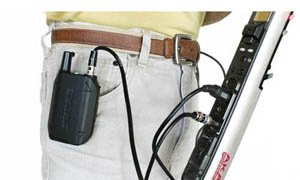 user to configure transmission channels to avoid interference with other devices simultaneously broadcasting on 2.4 Ghz. The transmitter can be seen in the photo on the left plugged into the audio out jack of the EWI. It uses a rechargeable battery that lasts about 17.5 hours between charges. A second battery can be charged in a convenient compartment on the front of the main receiver so a quick swap of batteries can avoid any downtime. The rack-mounted receiver plugs into the power strip in the travel case.
user to configure transmission channels to avoid interference with other devices simultaneously broadcasting on 2.4 Ghz. The transmitter can be seen in the photo on the left plugged into the audio out jack of the EWI. It uses a rechargeable battery that lasts about 17.5 hours between charges. A second battery can be charged in a convenient compartment on the front of the main receiver so a quick swap of batteries can avoid any downtime. The rack-mounted receiver plugs into the power strip in the travel case.
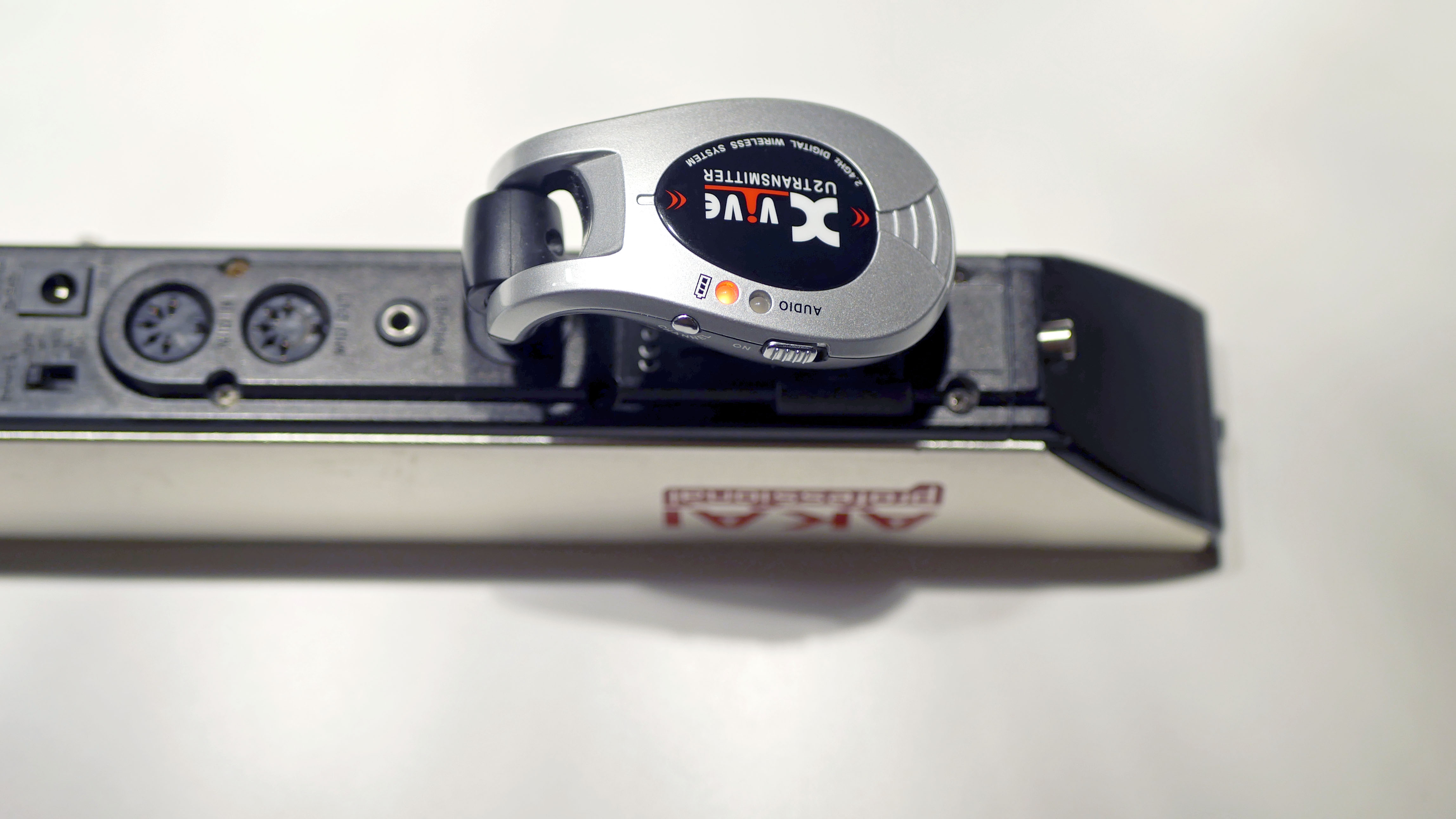
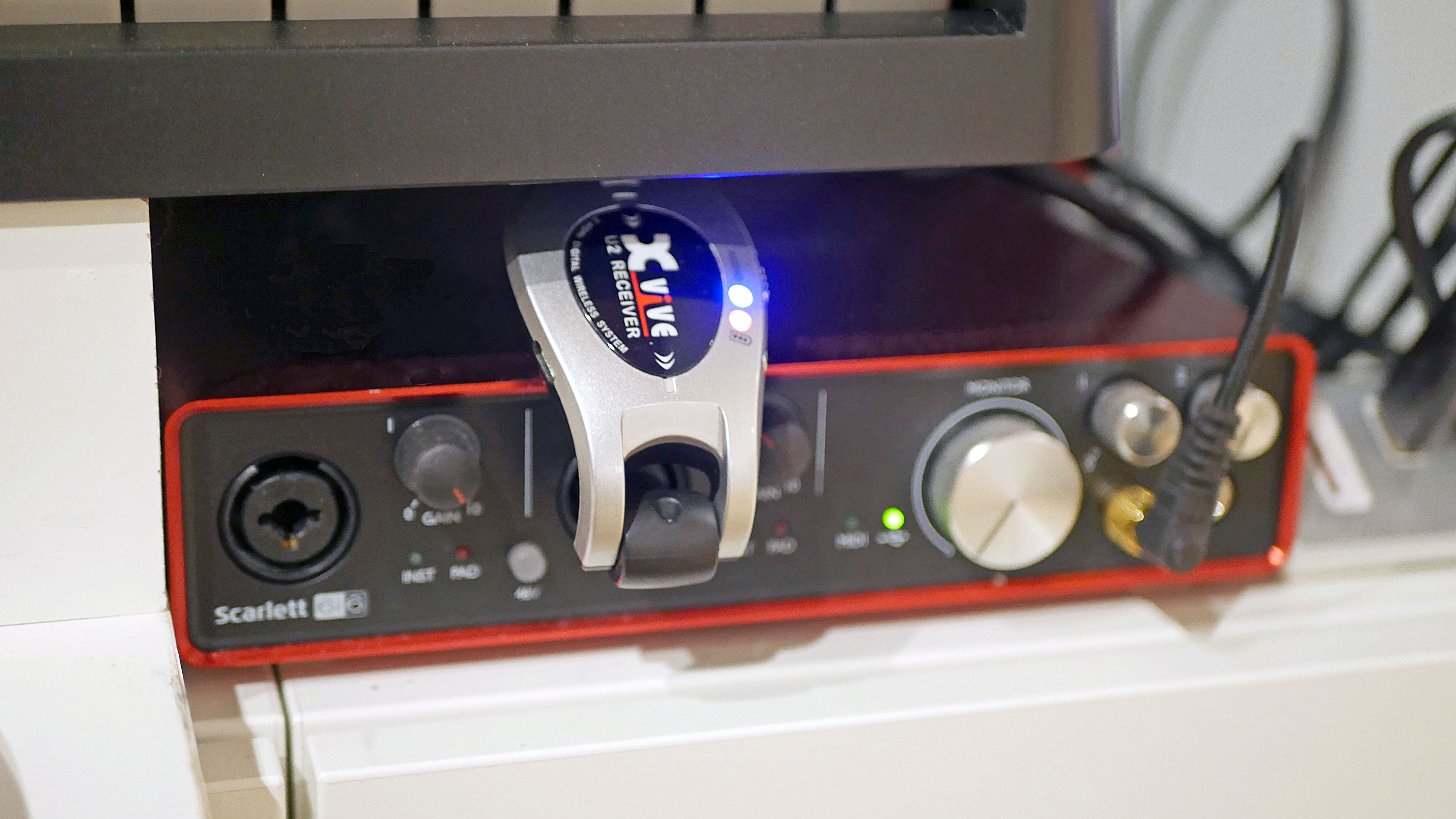
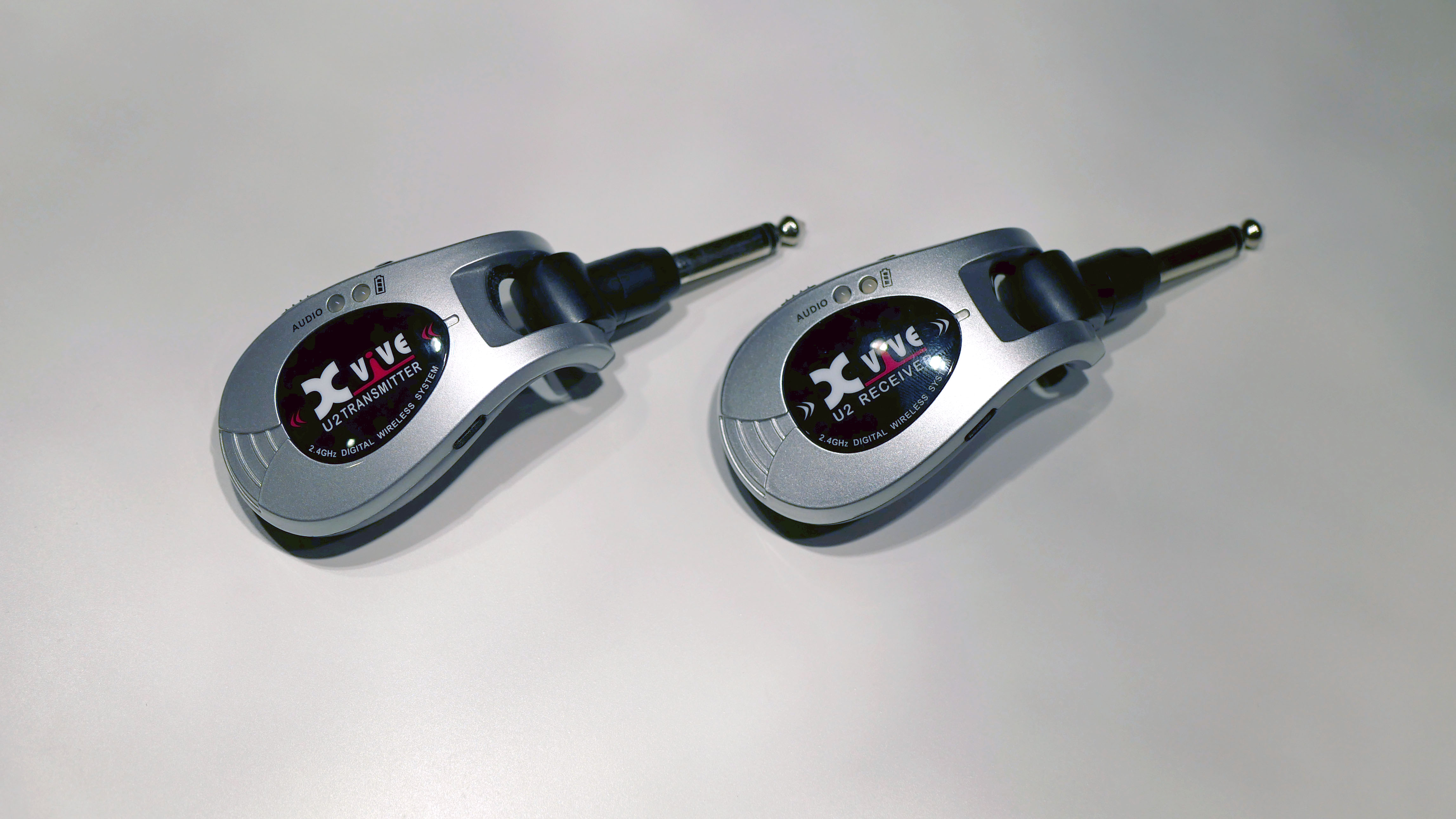 A new wireless audio option is both more compact and less expensive - the Xvive U2. It consists of two small plugin units - a transmitter and a receiver. The transmitter is light and plugs into the EWI audio out jack. The receiver plugs into the microphone/line in on the computer audio interface. Battery life is about 5 hours and is charged by USB.
A new wireless audio option is both more compact and less expensive - the Xvive U2. It consists of two small plugin units - a transmitter and a receiver. The transmitter is light and plugs into the EWI audio out jack. The receiver plugs into the microphone/line in on the computer audio interface. Battery life is about 5 hours and is charged by USB.
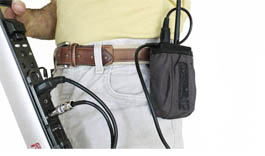 For sending MIDI data to the VL70m module I use a MIDI Jet Pro wireless MIDI unit which is designed to handle the huge flood of data from a source like the EWI without collapsing in a heap under the strain. It too has a large broadcast range so there are no worries about wandering beyond its reception capabilities. Again, excellent battery life. The receiver uses a transformer plugged into a power strip in the travel case.
For sending MIDI data to the VL70m module I use a MIDI Jet Pro wireless MIDI unit which is designed to handle the huge flood of data from a source like the EWI without collapsing in a heap under the strain. It too has a large broadcast range so there are no worries about wandering beyond its reception capabilities. Again, excellent battery life. The receiver uses a transformer plugged into a power strip in the travel case.
I also employ a Behringer FCB1010 MIDI foot controller for convenient and rapid switching, in banks of ten, between commonly used instruments in the Yamaha VL70m . The two assignable pedals also come in handy for programmed growl effects and cc07 volume control.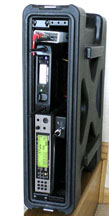
The SKB two unit rack-mount travel case contains the VL70m module, the Shure audio and MIDIJet Pro receivers, a tiny Behringer MX400 4 channel mixer, and a Belkin remote controlled power strip. In combination with the Bose L1 Compact it accomplishes quick setup and tear down times for the entire system. It usually takes less than 10 minutes to setup and tear down and it is built like a tank. All cabling and power switching can be stored in the end covers for efficient transport. During system setup it's just a matter of plugging in the ends of a few cables and everything is set to go.
![]()
EWI Stands
 There was initially no real EWI stand available so I constructed an EWI stand out of a brushed nickel paper towel holder and sundry plumbing parts for about $20. That useful contraption is seen in the photo on the right. I used it on gigs for a couple of years.
There was initially no real EWI stand available so I constructed an EWI stand out of a brushed nickel paper towel holder and sundry plumbing parts for about $20. That useful contraption is seen in the photo on the right. I used it on gigs for a couple of years.
In day-to-day work in the studio I use wall mounted Hercules guitar hangers for the EWIs. The neck of the EWI fits into the intended position of the neck of the guitar in this mounting arrangement,seen in the photo on the left. The weight of the instrument automatically closes the gripping mechanism while tilting nicely to hold the EWI in a vertical position.
this mounting arrangement,seen in the photo on the left. The weight of the instrument automatically closes the gripping mechanism while tilting nicely to hold the EWI in a vertical position.
I also use a Hercules stand version of this type of guitar mount for gigs where it can accommodate two EWIs. The photo on the right shows the stand with both the EWI 4000s and the EWI USB. The stand folds into a compact form that fits nicely into a gig bag containing the EWI case and sundry additional accessories.
![]()
What should an EWI player be called?
 Should it be just an EWI player? Or might it be something more unusual like an EWI-ist? Or, perhaps, an EWI-er? How about an EWI-ophonist or an EWI-ator? Could it be an EWI-sician? Maybe an EWI-ecialist? Or just A Lazy Bastard as shown in the picture to the left? We'll need to leave the final determination for History to sort out.
Should it be just an EWI player? Or might it be something more unusual like an EWI-ist? Or, perhaps, an EWI-er? How about an EWI-ophonist or an EWI-ator? Could it be an EWI-sician? Maybe an EWI-ecialist? Or just A Lazy Bastard as shown in the picture to the left? We'll need to leave the final determination for History to sort out.
![]()







